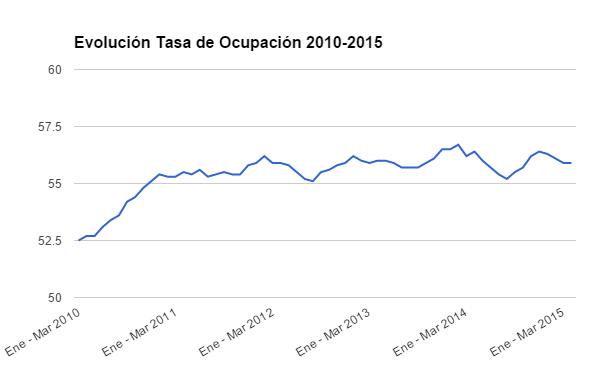In the last few weeks, for the purpose of increasing the numbers of ‘those who do not want to work’ has given rise to any controversy, which has been party to doubt the data of the INE. As the theme, finally, concerns itself with the figure of unemployment (as it could be low when the labour market situation would not be good), and the lack of handling of the distinction of earnings and inactive, would not be of more then search for a number that does not depend on such a distinction. However, this figure exists-and in fact, the INE publishes: Is the occupancy rate, which is the simple relationship between the population of working age (15 years or more) and the occupied. Any problem that existed in relationship with as the INE measures unemployment and inactivity would not be affected by the above.
If you use the data from the New National Employment Survey from 2010 onwards are the following results:

As can be seen, during 2010 we observed a significant increase (from 52,5 to around 55-56), and then from 2011 onwards is maintained -great lines in the range of 55-57 points. Appreciate seasonal effects stable. 2014 there was a fall (jan-mar 2014 is 3 tenths higher than jan-mar 2015) , but in fact at the beginning of 2014 had been relatively higher (jan-mar 2015, for example, has the same value, 2012 and 2013).
In other words, after a significant increase in the chilean economy has kept you busy the same rate of the population in the last 3 or 4 years. As the population in question has increased, this implies an increase in overall employment (for example, jan-mar 2013 had 7,73 million and occupied jan-mar 2015 has 7,97 million employed. (In the long-term indicator of employment, which compares with the population older than 15 years should have a downward trend, due to aging of the population -but that effect should be minor given that we analyze only 5 years).
The impression of stability that gives the rate of unemployment can be misleading due to the issue of measurement, but at least it is comparable to the impression given by the examination of the occupation. By the way, stability does not mean good situation, but the goal of this post was to provide background on the situation, not to evaluate
NOTE. With regard to the discussion on ‘who do not want to work’ -facts and figures that seem so anomalous. My first impression was that there could be a confusion with the discouraged (those who leave to seek work, then not find), but, in fact, the figures from the INE distinguish them, so that my impression was wrong. On this group, the newsletter of the INE tells us: “According to reasons of non-search or non-availability, the first incidence on the increase in the economically Inactive, and for the fourth consecutive time, were Inactive with No Desire to Work, explained mostly by young women” (Bulletin Employment Quarterly 199, INE, p 2, available here). And in that group, that an important part you can still rest in the rest of your family as a source of lift, the situation may be less anomalous. At least in general in Latin american societies has been discussed about the NINI (neither working nor studying) so that this anomaly would be a common to the region, and would represent a real trend, and not a ‘deception’ of the INE (and by the way, may well represent a problem-at least, this is what you see those who argue for NINI).
